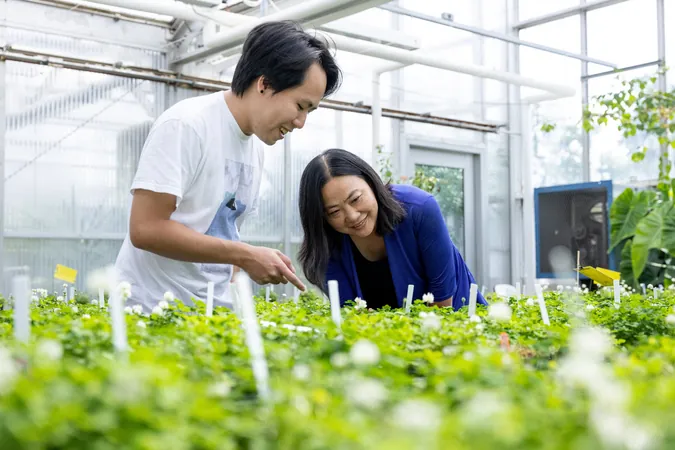
Revolutionary Finding: How Plants Mastered the Art of Genetic Adaptation!
2024-11-06
Author: Noah
Groundbreaking Study Overview
In a groundbreaking study, biologists from Washington University in St. Louis have unveiled how plants have evolved unique mechanisms to bypass genetic instructions embedded within their DNA. This exciting discovery not only sheds light on plant resilience but also offers a promising avenue for enhancing agricultural practices to better cope with climate change.
Research Led by Professor Xuehua Zhong
Led by Professor Xuehua Zhong, the research, published on November 6 in *Science Advances*, dives deep into the intricacies of DNA methylation—a fundamental biological mechanism where methyl groups are added to DNA to regulate gene expression. This process is paramount as it determines how plants react and adapt to environmental stresses such as extreme heat or drought.
Enzymatic Differences Between Plants and Mammals
Zhong's research zeroes in on the difference in DNA methylation processes between mammals and plants. Interestingly, while mammals have only two key enzymes for adding methyl groups, plants are equipped with multiple enzymes operating under different DNA contexts. Zhong poses an intriguing question: “Why do plants require extra methylation enzymes?”
The Role of CMT3 and CMT2 Enzymes
The focus of the study was on two specific enzymes, CMT3 and CMT2, which are crucial in the methylation of DNA. CMT3 targets CHG sequences, while CMT2 specializes in CHH sequences. Although they belong to the same chromomethylase family, their functional divergence stems from evolutionary duplication events that have endowed plants with additional genetic tools.
Key Differences in Amino Acids
Utilizing the model plant Arabidopsis thaliana, Zhong and her colleagues unearthed that CMT2 had lost the ability to methylate CHG sequences due to the absence of an essential amino acid, arginine. “Arginine’s positive charge allows it to interact strongly with the negatively charged DNA,” explained Jia Gwee, a graduate student involved in the research. This key difference in amino acids—valine in CMT2—was crucial in determining the unique roles of these enzymes.
Reverting CMT2's Functionality
In a twist of fate, the researchers were able to revert CMT2 back to its original form by introducing arginine, allowing it to methylate both CHG and CHH sequences. This astonishing discovery points to the idea that CMT2 was initially a backup for CMT3 but eventually carved out its own distinct role as plants faced genomic complexity.
Structural Role of CMT2 in Plant Evolution
Zhong highlights that the structure of CMT2 plays a significant role in plant evolution. Its long, flexible N-terminal helps maintain protein stability, which contributes to genomic integrity and enhances resilience against environmental pressures. This structural adaptation might explain why plants with CMT2 have flourished in a diverse range of habitats worldwide.
Insights from the 1001 Genomes Project
Indeed, much of the data that informed this study was derived from the 1001 Genomes Project, which catalogs genomic variation among different A. thaliana strains globally. By studying this comprehensive data set, the researchers believe they're able to transcend conventional laboratory settings and observe how these plants survive and adapt in the wild.
Conclusion and Implications for Agriculture
Zhong surmises that the evolutionary journey of A. thaliana reflects its exceptional capability to withstand adversities, potentially due to the diverse methylation processes influenced by transposons. “One jump could mean the difference between thriving and perishing in harsh conditions,” she concludes.
As climate change accelerates, understanding how plants adapt at the genetic level could catalyze revolutionary techniques in agriculture, ultimately securing our food sources in an ever-changing environment! The findings not only open doors for future agricultural innovations but also deepen our comprehension of plant resilience and evolution—a crucial treasure trove for scientists and farmers alike.









 Brasil (PT)
Brasil (PT)
 Canada (EN)
Canada (EN)
 Chile (ES)
Chile (ES)
 España (ES)
España (ES)
 France (FR)
France (FR)
 Hong Kong (EN)
Hong Kong (EN)
 Italia (IT)
Italia (IT)
 日本 (JA)
日本 (JA)
 Magyarország (HU)
Magyarország (HU)
 Norge (NO)
Norge (NO)
 Polska (PL)
Polska (PL)
 Schweiz (DE)
Schweiz (DE)
 Singapore (EN)
Singapore (EN)
 Sverige (SV)
Sverige (SV)
 Suomi (FI)
Suomi (FI)
 Türkiye (TR)
Türkiye (TR)